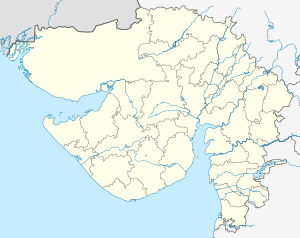Saiyad Usman Mosque
| Saiyad Usman Mosque and Tomb | |
|---|---|
 Saiyad Usman Mosque, 1866 | |
| Religion | |
| Affiliation | Islam |
| Status | Active |
| Location | |
| Location | Ahmedabad |
| Municipality | Ahmedabad Municipal Corporation |
| State | Gujarat |
| Geographic coordinates | 23°02′53″N 72°34′10″E / 23.0480301°N 72.5694835°E |
| Architecture | |
| Type | Mosque and tomb |
| Style | Indo-Islamic architecture |
| Funded by | Mahmud Begada |
| Completed | 1460 |
Saiyad Usman Mosque, alternatively spelled as Syed or Saiyyed, also known as Usmanpura Dargah or Roza or Saiyad Oosman Mausoleum, is a medieval tomb and mosque in Usmanpura, Ahmedabad, India.
History
Saiyad Usman was the minister of Qutubul Alam, also known as Saiyad Burhanuddin. He founded the Usmanpura village which is now the part of Ahmedabad. He died in 1458 and the mausoleum dedicated to him was built by Mahmud Begada in 1460. It is architecturally similar to Ganj Baksh tomb at Sarkhej Roza.[1][2]
The mosque was havily damaged in 2001 Gujarat earthquake but was restored by Archaeological Survey of India in 2009.[3][4][5]
Architecture
The mosque, with a minaret at each end, is in the style of the Sarkhej Roza. The mosque is a pure Hindu style without an arch. Inside, the arrangement of pillars, is neither so simple nor so clear as at Sarkhej. One peculiarity of tho tomb is that its dome is supported on twelve instead of on eight pillars. This change gives much variety and the tomb is altogether the most successful sepulchral design carried out in the pillared style at Ahmedabad.[1]
Gallery
-
North part of the mosque
-
View from Northend
-
The interior of the mosque
References
- ^ a b Gazetteer of the Bombay Presidency: Ahmedabad. Government Central Press. 1879. p. 284.
 This article incorporates text from this source, which is in the public domain.
This article incorporates text from this source, which is in the public domain.
- ^ "AHMEDABADS OTHER ROZAS". Times of India Publications. 25 February 2011. Retrieved 7 December 2014.
- ^ "PEARLS OF PAST: Need Some Elbow Room". The Times of India. 25 November 2011. Retrieved 7 December 2014.
- ^ "Mosque owners, ASI lock horns". The Times of India. 10 September 2007. Retrieved 7 December 2014.
- ^ "ASI asked to take care of monuments". The Hindu. 13 June 2001. Retrieved 7 December 2014.





